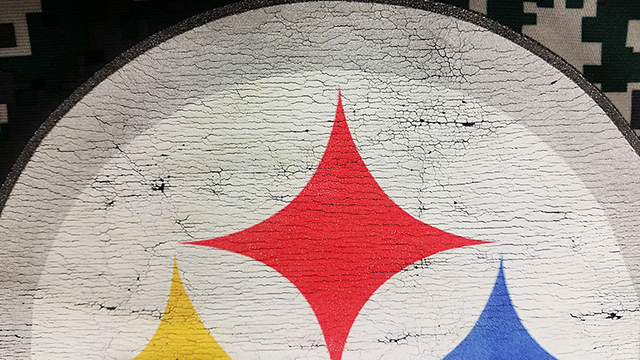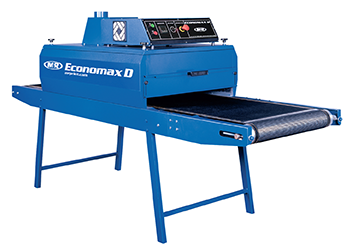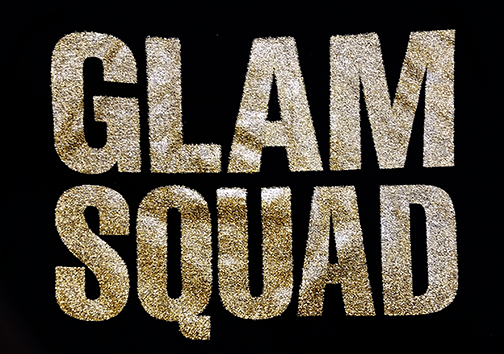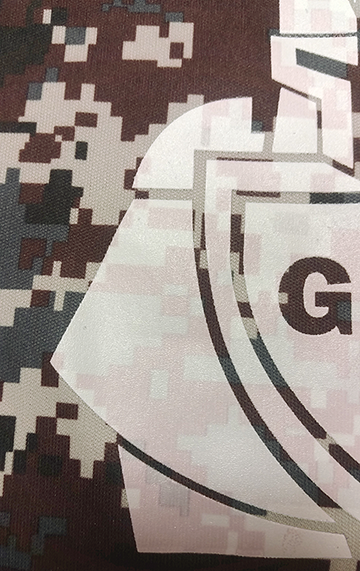Tips 0n Curing: Dryers And Inks
May 04, 2017
 Here is an article written by our very own Kieth Stevens that was printed in the December 2016 issue of Stitch & Print Europe.
Here is an article written by our very own Kieth Stevens that was printed in the December 2016 issue of Stitch & Print Europe.
Dryers and Curing
By Kieth Stevens
One of the coolest things about plastisol is that it doesn’t dry unless you
apply the proper heat for it to “dry” and because of this I have stained a lot of clothes and a few carpets.
Plastisol is very stable and predictable. So when I receive a tech call for some help with curing, it usually comes down to two things: The temperature was too low or not enough time was spent under the heat. Since curing is a topic I get asked about a lot, let me reiterate that the best way to cure plastisol ink is with a conveyor (or belt) dryer. Not a hair dryer or a craft dryer, a real conveyor dryer, made for the purpose of curing inks.
Types of Dryers
Dryers come in many forms, with ones where

the heat comes from a flame and ones that use a heating element (such as an infra-red element) to produce the heat.
Gas dryers typically generate heat using actual flames and moving air across the flames to reach the desired temperature inside the dryer. The hot air is then blown out across the conveyor belt, creating an even heat level throughout the length of the chamber. Heat generated from a flame is very dry and able to cure or dry water-based inks, including discharge type inks very well. It also is still the most preferred form of curing for plastisol inks, but definitely the best dryer type for water base types of inks. Water-based inks must have the water removed from the ink film before the chemistry will crosslink the molecules and become solid.
Keep in mind that some water-based inks such as discharge can dry if just exposed to the air, but will not discharge or be cured. In order for discharge to work the ink must still be exposed to heat in order for the discharging to work.
Electric dryers typically use infrared heating elements installed throughout the heat chamber directly above the conveyor belt. Electric dryers tend to be less expensive than gas ones, and come in smaller sizes. However, the lower cost dryers can have hot spots where heat is concentrated unevenly in the chamber and cause the fabric or ink to scorch if not handled properly. Some higher-quality electric heaters have internal fans that blow the air inside the chamber, thus creating more level temperatures throughout.
Retrospective
When I began writing this article, I could not help but remember the time were the company I was working for had to close their main printing plant and the owner asked if I could help him keep some of the accounts by setting up a small shop in his house located in Chatsworth, California.
We ran some big extension cords from the electrical panel on the opposite side of his one-level ranch style house. Then I was asked to construct a dryer from scratch. So here is what I came up with:
First I needed a base with legs and for that I used a small wrought iron fence material, the kind that you can pick up from your favorite home improvement retailer. I then used some 4 inch PVC pipe to make the rollers for the conveyer with some cheap bearings on each side. I found a DC motor with a variable speed controller from Grainger to make the conveyor move. To top everything off, we used a large 220 volt infared heating panel to make things hot enough. This was so primitive but you know what? It worked.
Later on when the company started earning profits again and we could move back into a larger place, we were able to use a real dryer. Some of my ex-coworkers that I am still in touch with after 30+ years still comment on that dryer. Just a few years ago I heard that someone saw that dryer in some storage place that the owner of that shop stored it in a long time ago.
Curing Plastisol Inks
So back to curing: Plastisol needs to reach a minimum of 320°F (160°C) to be considered cured. “How long does that take” you ask? Well that’s the magic question. Most print shops don’t have a clue. Plastisol ink is really not that complicated. I like to compare plastisol ink to a cake or cookie batter. Like the cake batter, there are several components that make up plastisol ink: There is the “flour” (resin), the “water” (plasticiser), “eggs” (special additives for stretch or adhesion etc.), and “flavorings” (color pigments). You get the idea.
Both, the cake and cookie may require the same temperature to fully cook, but the cake requires more time. To illustrate another example, if you raise the temperature of the oven hoping for the cake to bake in the same amount of time as a cookie, you would run the risk of burning the top and bottom of the cake while the center will still be undercooked.
Similarly then, when curing thick ink layers (high density or puff prints for example) or thin layers (i.e. 4-color process prints), the number one thing to remember is that for plastisol to fully cure, the whole ink film (its thickness) – from top to bottom, including the center – must reach the 320°F (160°C) temperature.
What happens if ink is under-cured? At the very least, the print will crack if it is stretched. If the ink film was only cured (seared) at the top outer level or only partially cured on the rim of the design (many tech calls I’ve received), the ink may partially wash off.
Curing Tips

Let me address curing shiny or white inks. Shiny inks, such as metallics, glitters, reflectives and shimmers contain metallic flakes or have metallic coatings on the beads that are mixed into these inks’ base which actually reflect heat. Similarly, white inks also tend to reflect heat. As such, the underlying ink may not reach the required curing temperature.
It is important to remember that “time is your friend” when it comes to curing. Slow down the dryer belt and run the print through the dryer a bit longer. Be sure to set the temperature no lower than 320°F when curing plastisol inks. However, don’t set the temperature too high, as that may scorch the fabric as you slow the dryer speed. The extra time in the dryer will allow the ink to absorb more heat and cure correctly.

Here are some other special instances that I would like to discuss: There are some low cure inks out there that are specially designed to be used on heat sensitive fabrics. These inks typically cure at around 275°F to 285°F (135°C-140°C). These inks are key when printing on some polyester fabrics which have either low-grade dye in them or have been decorated with a dye sublimated design like the popular camouflage prints. These type of designs will bleed (dye migration) through a normal polyester ink easily and will make even some of the best polyester white inks turn color. Being able to cure these inks at a lower temperature can (I say can and not will) help contain the polyester dyes. And remember, always cool your polyester shirt as soon as possible and never fold them while hot and put them in the box. That is a formula for disaster!
Another item that I want to discuss is the curing of Puff or Suede type of inks. When curing these type of inks, it is possible to ruin the desired effect by not monitoring the ink closely as it is being cured. If the ink is under-cured the ink will look shiny and under-cured, but when it is over-cured it can also look shiny and under-cured, so you must keep a close eye on it and set the cure time and temperature properly. Watch the ink as it is being cured and you can see the ink rise in the oven. It will start to peak or look very dry in appearance but if you are not careful, it will begin to collapse and loose its loft and start to look shiny or wet. This is the point when the ink is over-cured. Try and stop the curing when the ink has peaked and looks dry.
There have been times when I have purposely over-cured an ink such as high density or gel inks to get that really shiny look, but usually this is on a dark or black garment that will not appear scorched due to the excess heat.

Last Tips
A couple of additional tips I wanted to bring up: Try to keep your dryer away from drafts that can accrue from open windows or doors. Drafts can create fluctuations in dryer temperature and may lower it enough to cause curing issues if not monitored. Also monitor the weather conditions for humidity, since a T-shirt can absorb up to 10 percent of its weight in moisture, which can then slow or hamper the curing process.
Test your dryer using an infrared hand-held temperature gun that you can find at most hardware stores and check your dryer by testing the shirt temperature as the shirt is exiting the tunnel. Be sure to check the temperature on the left and right side on the tunnel, as you may find hot and cold spots that need to be avoided.
Remember, when curing, time is always your friend. Heat is needed but can become an enemy if you don’t control it.
Kieth Stevens is the Western regional sales manager for International Coatings. He has been teaching screen printing for more than 10 years and is a regular contributor to International Coatings’ blogs.
International Coatings manufactures a complete line of Centris™ non-Phthalate screen printing inks, including a wide variety of whites, specialty inks, special effects inks,color matching systems, additives and reducers. In addition, International Coatings also manufactures a line of AXEON™ non-Phthalate, non-PVC special effects inks. For more information on our products, please visit our website at www.iccink.com.


